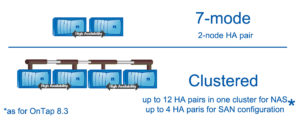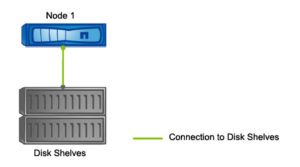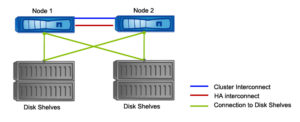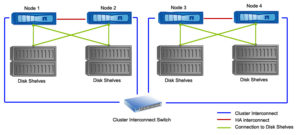Within this post I would like to start series of articles about Clustered Data ONTAP (sometimes shorten cDOT, sometimes c-mode). I will start with explaining high level differences between Clustered-mode and 7-mode. If you are completely new to NetApp, don’t worry, this comparison will be also useful to You, because cDOT is strongly connected to 7-mode, and even if you plan to work only with new cDOT environment, it is really good to know at least basics about 7-mode.
Data ONTAP Scaling
In this section I would like to share one of the most important difference between 7-mode and c-mode. As you may already figured that out from the name itself, c-mode gives much better scaling options.
As you can see, 7-mode normally is configured in 2-node HA (High-Availability) configuration. cDOT is also configured into HA pairs, however within cDOT you can connect up to 12 pairs (in NAS configuration) or up to 4 pairs (in SAN configuration) in one cluster! (Please note this numbers are correct for Data ONTAP 8.3, it is very possible that within newer releases, those numbers will increase). Does it mean that you have to do so? Of course not! You can configure 7-mode NetApp with only one Filer (NetApp array), the same you can do using cDOT configuration. In fact you can quite often meet cDOT configuration made out-of one HA pair.
In fact that might be the main feature of Clustered Data ONTAP – you can start with 2-node Cluster, and once your environment grows you can easily non-disruptively add new nodes to your cluster. More details will come in more advance articles.
Hardware differences
Look at the title of this article. It basically says ‘c-mode vs 7-mode’ ONTAP. What is ONTAP? Well.. It is operating system. So it’s more-or-less independent from hardware layout. Does it mean you can transfer Your 7-mode NetApp to Clustered mode? In most cases the answer is yes! Not all arrays (especially older ones) are supported though. For more information about specific models you can always go to NetApp Hardware Universe. As for some details, you can choose from FAS2200, or FAS2500 series for your midsize projects, or for FAS6200/FAS8000 series for enterprise storage.
However, if you plan to connect more than two Filers into once cluster, there is one hardware difference. For Single HA configuration, there is no physical difference between 7-mode and c-dot configuration. It is sometimes called Switchless Two-Node Cluster. However if you with to configure more HA pairs, you need to apply Switched Cluster configuration. For that you require an separate Ethernet network with dedicated switch (best practice will be two switches, to make your network redundant).
Single-Node Cluster
Single-Node Cluster is the cheapest, and easiest configuration. However it has strong disadvantage: storage system is the single point of failure. If our controller fails, customers loose access to the data.
Such configuration also does not enable any non-disruptive operations. Every controller (node) reboot is equal to downtime from customer point of view.
Switchless 2-node Cluster
Such configuration is very similar to 7-mode HA configuration. The only small difference is that within c-mode configuration there is additional cluster interconnect. Cluster interconnect, as a standard Ethernet infrastructure, provides the scalability with a networking infrastructure. It is required for cluster traffic.
Such solution it is fault tolerance. Even if one node fails, second node can takeover its responsibilities. Each partner is mirroring the data for each NVRAM, so even in sudden failure of one node that is no risk of data loss.
Clustered Data ONTAP configuration
As mentioned before, clusters of more than two nodse need a supported switch to attach each node to the cluster interconnect.
Of course you cannot choose whatever switch you would like. It has to be supported cluster interconnect switch, as for example NetApp CN1610, or Cisco Nexus 5596. If you have a 2-node cluster, but you plan an expanstion in the future, it is a good approach to install Cluster Interconnect Switch for your 2-node configuration to enable future online expanstion.




The best way of teaching c-mode and 7 mode.
Very useful and well explained, thx ! 🙂